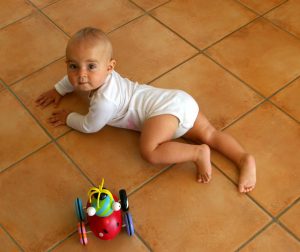Baby & Child motor development: from 2 month old to 1 year!
After last week blog post about primitive reflexes in new-born, we now present “normal” motor evolution during the first year of your baby.When your baby reaches 2 months:
- Primitive reflexes present at birth start to slowly fade out
- Sitting: your baby can hold his head for a few second and then fall on the side. Your infant is unable to stabilise is spine/trunk at this point and will just collapse on himself.
- On his back: his arms and leg are kept flexes in the air
- On his tummy: your infant can maintain himself on his forearm and lift his head at 45°. Hips bones are kept flat on the floor and his legs extended.
- Your baby close and open his hands

When your baby reaches 3 months:
- Sitting: your baby is now able to maintain his head straight. Neck and upper back start to be controlled but the lower back is still too weak (by placing your hands on your baby’s lower back you can give the extra help to help to stay sit)
- On his back: your infant start to stretch and flex his legs and arms and to be passionate by his own hands!
- On his tummy: he can now push on his forearm and lift his head at 90°
- Your baby start to be able to hold an object but not for long
When your baby reaches 4 months old:
- Sitting: Head is maintain straight and your baby developed a better control of the rest of his spine
- On his back: your infant should start to roll on his side
- On his tummy: lift his weight with his elbow or make swimming like movement (arms and leg in the air and spine extended)
- Your baby bring his hands together, can take a tissue place on his face and start to reach for toys placed close to him.

When your baby reaches 5 months:
- Sitting: if you help your baby by holding his hands he can now pass from lying to sitting. He lifts his head and bend his legs to sit.
- On his back: your infant start to make circle with his legs and play with his feet
- On his tummy: he starts to extend his arms but can’t grab object yet in this position. Your child is able to roll from his belly to his back (try to stimulate your baby to do it on both side, they often have a preferential side!)
- Your baby can grab objects between his palm and his last 3 finger and bring it directly to his mouth!
When your baby reaches 6 months:
- Sitting: your baby can stay sitting by stabilising with one of his hands
- On his back: lift his head and his shoulders. Your infant can also try to pass to a sited position by himself even though without success. He should now be able to grab his feet and sometimes try to eat them! Your baby also pass from his back to his belly
- On his tummy: he push on his hands to lift himself
- Held standing up, your baby try to jump!

When your baby reaches 7 months:
- Sitting: your baby can hold sitting without using his hands to stabilise and can adapt to minor push
- On his back: he can grab and put his toes in his mouth
- On his belly: your infant raise himself with one hand and grab an object with the other one
- Held in standing position: your baby jump and can also squat!

When your baby reaches 8 months:
- Sitting: your baby hold this position and can move without falling
- On his back: he starts to lift himself in sitting position rolling on a side and pushing with his upper limb
- Rolling on the side is now the best way to move around the room for your baby!
When your baby reaches 9 months:
- Sitting: your baby is now able to turn around when sitting
- On his back: he is mastering how to pass from lying to sitting
- On his belly: your infant starts to crawl, even if at first it is easier to go backward!
- Your baby starts to stand up by himself holding to furniture! But fall after few seconds

When your baby reaches 10 months:
- Your infant walks on his four
- And is able to stand up still using furniture make a few steps and fall
- Some babies actually let themselves fall when they realise they are not holding anything!
When your baby is between 11 and 12months old:
- Your baby still walk on his four but now using more his hands and feet
- It is also the beginning of the firsts steps by holding the hand of an adult or pushing a pushchair
- Your infant also start to walk around the house holding to furniture
- He can also squat and stand up by himself




